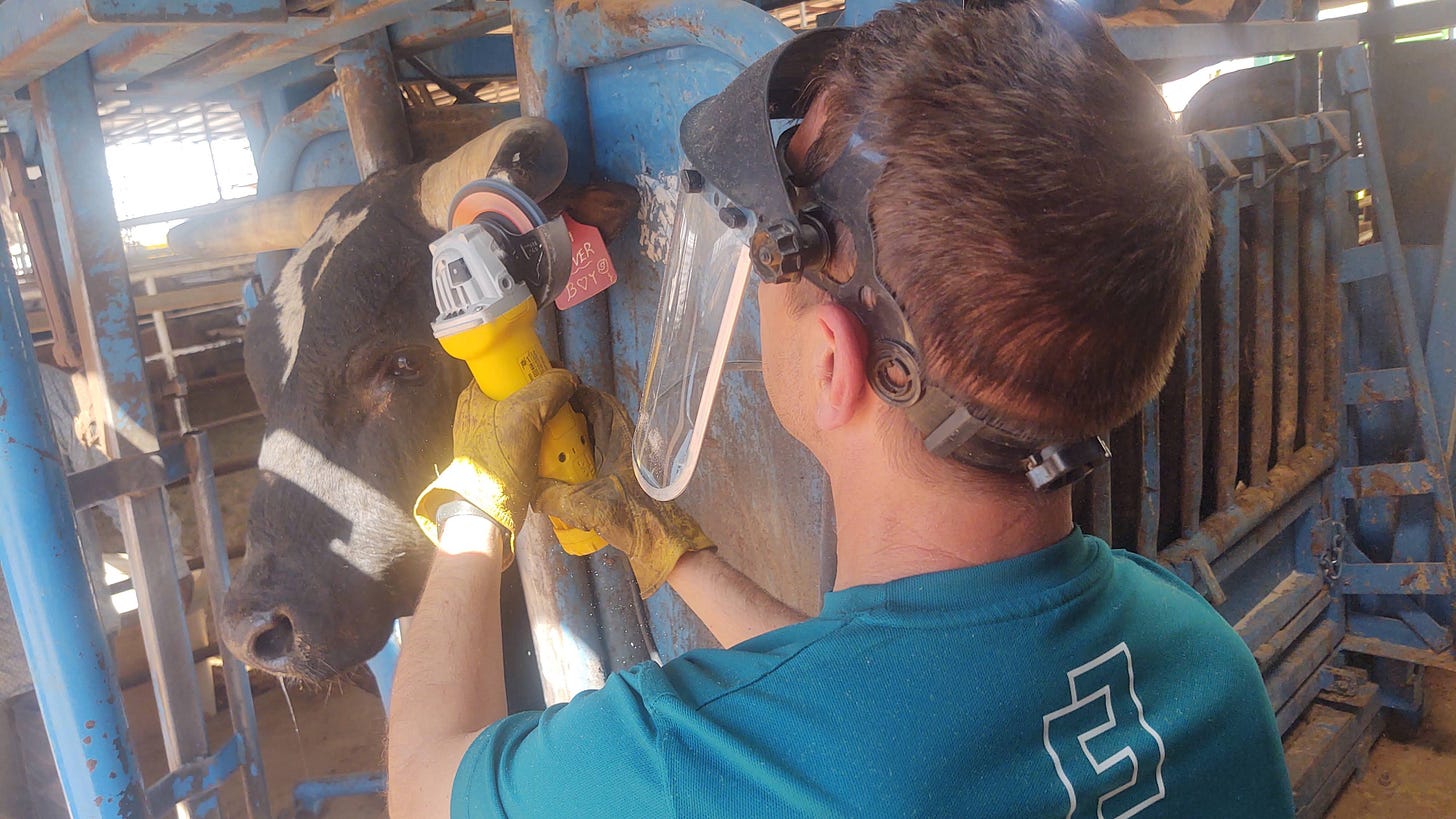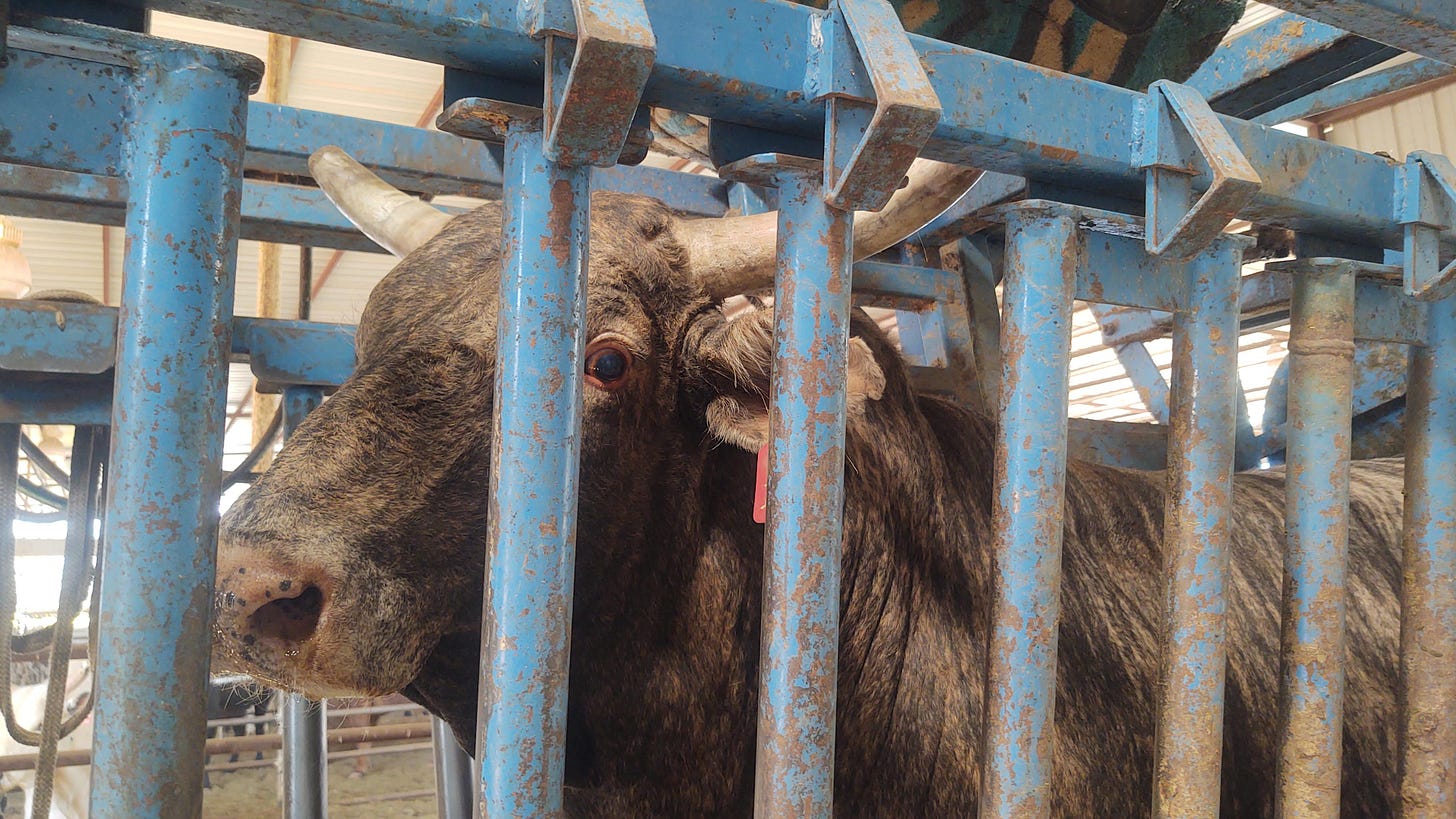If you enjoy this newsletter, please consider recommending it to others and becoming a paid subscriber. You’ll get dispatches about travel, adventure and #dadlife that will sometimes be heartfelt and profound, sometimes peel back modern parenting life for a look inside, and sometimes be, well, whatever this is. If you support my work, I would appreciate it.
This is the latest installment in a series commissioned by Cowboys and Indians Magazine called Western Work. So far I have worked on a dairy farm, bucked hay and shoveled pig shit. In today’s installment, I shaved bulls’ horns.
Today I learned what shaved bulls’ horns smell like
For a bucking bull to be “safe,” the tips of his horns have to be flat and as wide as a half dollar. That’s so that when — not if — he hits a rider (or rodeo clown or bull fighter) with them, the rider (or rodeo clown or bull fighter) will not be impaled.
Stock contractors use an angle grinder to sand a bull’s horns to those desired specifications, and when they do so, the resulting detritus smells like sawdust plus burning human hair plus a little pungency I don’t quite have a name for.
I learned all of this in the hours I spent at KEY Ranch in Page, Arizona, as part of an installment of a Cowboys & Indians project we’ve dubbed “Working The West,” in which I volunteer my amateur services for the real Western movers and shakers who tackle each day without complaint. What’s more interesting, hard, and real than raising bucking bulls? And what’s more interesting, hard, and real than making sure those bulls are safe?
On the sun-kissed day I visited KEY Ranch, it was horn-sanding day. Wait, no, a day like that deserves more pomp than that. It was Horn-Sanding Day. So, in addition to the mud, dirt, and excrement I would see at any ranch on any day of the year, I also encountered horn dust and blood, all to get bucking bulls ready for the 30 or so rodeos that KEY Ranch’s Jacob “Boss Man” McCabe will produce throughout the Southwest this year.
“Have you done anything like this? Ranch work?” Jacob asked, graciously overlooking my city hands, city skin, city clothes. “Nope,” I said. “Total city boy here.”
With that, we jumped right to work. The bulls were held in place by what is effectively an enormous vice. It is blue and looks like it has ribs, and getting the bull aligned in it is a three-person dance, with the bull a fourth and often unwilling partner. “They don’t like this chute,” said Jacob, whose grandparents started a network of businesses, including this ranch and a rodeo arena, that his mom now runs. “They know something’s happening when we’re over here messing around.”
A KEY Ranch employee named Hunter smacked the bull’s butt to get him to walk into the vice’s chute. Jacob played with the controls to “catch” the bull. At the front, a fellow named Sandoval worked like an interior decorator trying to get a couch in the exact right spot. “Unsqueeze him!” Sandoval called out for one bull who needed to scooch back a little. “Show him some daylight!” he said about another who needed to inch forward.
Fighting Through
Forward and back. Back and forward. That’s a good description of what happened to KEY Ranch and its associated businesses in the COVID years. The family’s primary business is a tour company called Ken’s Tours, which is run by Jacob’s mom, Michelle Monroe. It was started by Michelle’s parents, who are full-blooded Navajo, and many of their employees are Navajo.
During the pandemic in 2000, the Navajo Nation closed down, which forced the tour business to cease operations temporarily. Layoffs appeared imminent.
Instead, Monroe opened new businesses—a gym, a restaurant, a boutique and a coffee shop—and put the employees to work there.
“It’s a small town. We heard from other business owners. ‘What is going to happen? What are you guys going to do?’ People were laying off employees left and right,” she says. “We just couldn’t do that. We had some of these employees that have been with us for a very long time. We consider them our family.”
The tour company’s hiatus dragged on for 18 months. But like a cowboy on a bull, Michelle and Jacob hung on. Today the new businesses remain open and the tour business and ranch are thriving again.
“Michelle is part of what makes Page and LeChee [Arizona] such amazing communities,” says Gregg Martinez, Page’s economic development coordinator. “Michelle’s dedication to her staff has shown through in many more ways than just employment. There is a real feeling of family within her organization.”
Back To The Bulls
KEY raises horses, too, which I saw during a tour Jacob gave me. They grazed in a field that overlooks the Colorado River’s Antelope Canyon. If I were a bull, I would happily put up with having my horns sanded if it meant I got to look at that spectacular view every day.
I hoped to help prepare the horns because one is the number of times I’ll get to do that in my life. First, I watched Sandoval do it. I wanted to be confident the vice would do its job. I needed to make sure I wasn’t going to get impaled as I tried to make it impossible for the bull to impale someone else.
Soon enough, I grabbed the angle grinder, fired it up, and applied it to a bull’s horn. I noticed the smell immediately. The bulls moved their horns occasionally; it was like sanding a lazy Susan while standing on a teeter-totter. At one point, I forgot to put the facemask on and got bullhorn dust in my eyes and hair (for the first and last time (probably) in my life).
Sandoval looked like a sculptor preparing a work of art. By comparison, my horns resembled a child’s clay figure. But they didn’t have to look good; they just had to not impale bull riders. I succeeded there.
Jacob told me the bulls have nerves in their horns, so it’s not as though this process was painless. But I was eyeball-to-eyeball with them and observed no signs of discomfort, not even when a trickle of blood emerged from the center. This happened a couple of times. Each time, I staunched it with a soldering iron.
We prepared 12 of KEY’s 31 bulls, among them some of the best bovine athletes Jacob has raised. Rebel Yell has qualified for the finals of the Indian National Finals Rodeo for the last four years. He’s normally placid outside of the arena. Today, he wanted no part of the giant blue vice or the men coaxing him into it or the angle grinder I wielded to make his horns flat and as wide as a half-dollar.
Rebel Yell eventually calmed down enough for me to get him ready for competition. And he trotted peacefully away when Jacob unlocked the vice. “I hope he’ll make it in the big one soon,” Jacob says. “That’s my dream: To take stock to the National Finals.”
Can he do it? Absolutely. But it will take a lot of hard—and dirty—work.



Now you have a new fragrance for your essential oils for men start-up: "Shaved Bull Horns." That's gold!
Cool! Writing about bulls again. I never knew that is how it is done. Thanks for educating a PBR fan.